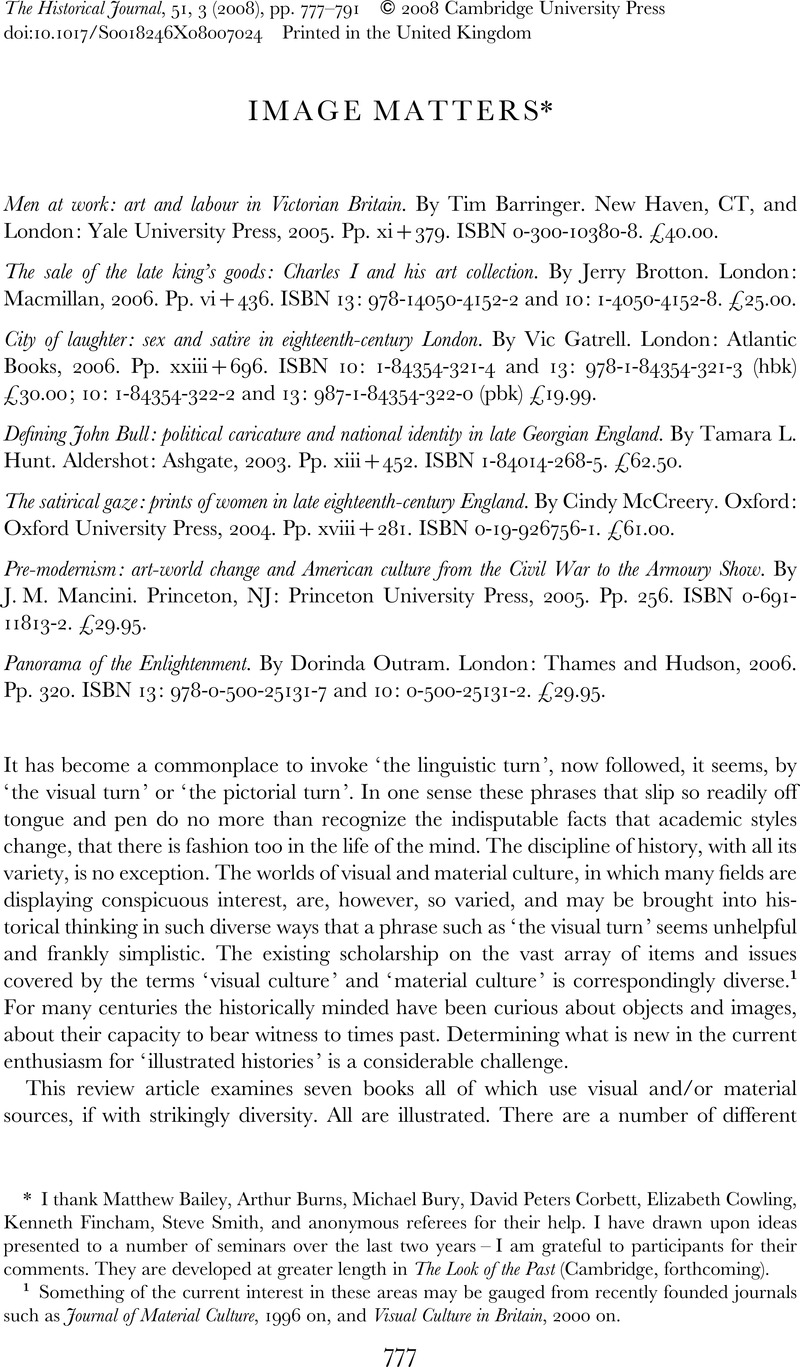Article contents
IMAGE MATTERS*
Published online by Cambridge University Press: 04 September 2008
Abstract

- Type
- Review Article
- Information
- Copyright
- Copyright © 2008 Cambridge University Press
References
1 Something of the current interest in these areas may be gauged from recently founded journals such as Journal of Material Culture, 1996 on, and Visual Culture in Britain, 2000 on.
2 Jacob Simon, The art of the picture frame: artists, patrons and the framing of portraits in Britain (London, 1996).
3 Michael Baxandall, Painting and experience in fifteenth century Italy (revised edn, Oxford, 1988), p. 152. Euan Cameron's edited volume, Early modern Europe an Oxford history (Oxford, 1999), falls into just this trap, see for example, p. 253, where a picture is captioned ‘Peasant market gardeners set off to market … ’ with no reference to the artist. The image turns out to be by Gainsborough (p. xi), no date, size, or medium is given. For the complexities of Gainsborough's rural scenes see John Barrell, The dark side of the landscape: the rural poor in English painting, 1730–1840 (Cambridge, 1980).
4 Richard Cust, Charles I: a political life (Harlow, 2006), esp. pp. 10–30, 148–71, 466–74.
5 Details of all works in the Primary Collection may be found on the website: www.npg.org.uk
6 Journal of the History of Collections, 1989 on; Francis Haskell, The ephemeral museum: old master paintings and the rise of the art exhibition (New Haven, CT, and London, 2000).
7 For example, Brotton makes the ‘ordinary people’ point on pp. 219, 258, 267; and assumes Protestant hostility to art on pp. 11, 232, 236.
8 Jonathan Israel, Enlightenment contested: philosophy, modernity, and the emancipation of man (Oxford, 2006), pp. 863–71; his eight ‘cardinal points’ that characterize the radical Enlightenment are listed on p. 866.
9 For example, I was unable to find information for images on the following pages: 132, 184, 238–9, 252.
10 David Mannings, Sir Joshua Reynolds: a complete catalogue of his paintings (New Haven, CT, and London, 2000), i, text, p. 198.
11 On bluestockings see Elizabeth Eger and Lucy Peltz, Brilliant women: eighteenth-century bluestockings (London, 2007).
12 J. Douglas Stewart, Sir Godfrey Kneller and the English baroque portrait (Oxford, 1983), p. 141.
13 Isobel Grundy, Lady Mary Wortley Montagu (Oxford, 1999), pp. 365 and 381; unfortunately the miniature is not illustrated.
14 Kim Sloan, ed., Enlightenment: discovering the world in the eighteenth century (London, 2003), which is extensively illustrated with 263 images and intended for a broad readership, and R. G. W. Anderson et al., eds, Enlightening the British: knowledge, discovery and the museum in the eighteenth century (London, 2004), which is based upon a conference and contains 89 illustrations.
15 Mark Hallet, ‘James Gillray and the language of graphic satire’, in Richard Godfrey, ed., James Gillray: the art of caricature (London, 2001), p. 23.
16 Antony Griffiths, Prints and printmaking: an introduction to the history and techniques (London, 1980), is useful; see also Tim Clayton, The English print, 1688–1802 (New Haven, CT, and London, 1997).
17 Derek Jarrett, England in the age of Hogarth (London, 1974): ‘Nobody saw these things more clearly than Hogarth and it was for this reason that Englishmen continued to gaze, for many years after his death, into the mirror he had held up to them’ (p. 11).
18 Exemplary works include Michael Bury, The print in Italy: 1550–1620 (London, 2001), who pays attention to the operations and processes of printmaking, the types of people who published prints, and printmaking as a business, and David Alexander on Richard Newton (1777–98), whose career was tragically short. He provides transcriptions of the wording on all the plates, pp. 115–39: Richard Newton and English caricature in the 1790s (Manchester, 1998).
19 Diana Donald, The age of caricature: satirical prints in the reign of George III (New Haven, CT, and London, 1996); Mark Hallett, Spectacle of difference: graphic satire in the age of Hogarth (New Haven, CT, and London, 1999); McCreery's work invites comparison with Sophie Carter's book, also based on a doctorate and published in the same year: Purchasing power: representing prostitution in eighteenth-century English popular print culture (Aldershot, 2004), which focuses on London.
20 Hallett, Spectacle of difference, and Carter, Purchasing power, for example, similarly adopt a metropolitan focus. See also Sheila O'Connell, London 1753 (London, 2003). The great pioneer in this field was M. D. George, Hogarth to Cruikshank: social change in graphic satire (London, 1967); her London life in the twentieth century was first published in 1925 (London and New York, NY).
21 Max Beerbohm, Selected essays (London, 1958), pp. 41–3.
22 For instance, compare p. 73 in Godfrey, James Gillray, with p. 324 in City of laughter, which reproduce the same 1788 print by Gillray, The morning after marriage – or – a scene on the continent. Size is an important factor here: the illustration in Godfrey is seven and three-quarter inches by six and a half, in Gatrell, four and a quarter by three and three-eighths.
23 Gatrell, City of laughter, p. 575; Arthur Burns and Joanna Innes, eds., Rethinking the age of reform (Cambridge, 2004), esp. the introduction and the chapter on art by Holger Hoock.
24 James Northcote, John Ruskin, 1822, oil on canvas, NPG 5973, 1267×1010 mm; it may be viewed on the website.
25 The width in inches of the pages in the books under review are: Brotton – five and three-quarters; Outram – eight and a half; Hunt – six; McCreery – five and three-quarters; Gattrell – six and an eighth; Barringer – eight; Mancini – eight.
- 5
- Cited by


